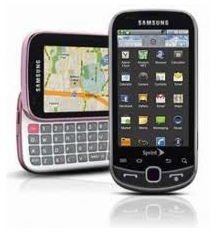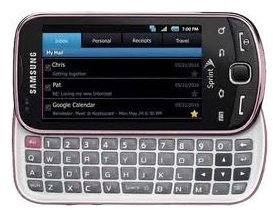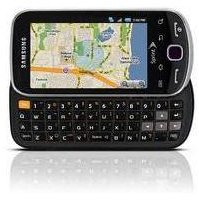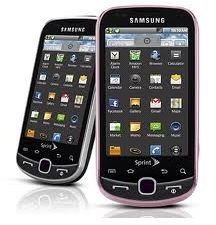Review of the Samsung Intercept: Replacement for the Samsung Moment

Released on July 11, 2010, the Samsung Intercept is technically a replacement for the Samsung Moment, although it looks like the Moment will remain in the Sprint lineup of phones for now. The Intercept is exclusive to Sprint, although with Sprint’s focus on 4G devices including the upcoming Samsung Epic 4G, you have to wonder just how much support a mid-range 3G device will get. The Intercept does run on Google’s Android operating system and includes a basic Samsung skin.
Design (4 out of 5)
From a distance the Intercept looks just like the Moment, but up close you can see that at 4.43 by 2.19 by .59 inches, it is a little more compact than its predecessor and oh what a difference that little bit makes. The Intercept feels good in my hand, not clunky or unwieldy. The corners are rounded in the right places and the back of the phone feels comfortable. The QWERTY keyboard slides in and out with ease and the transition from vertical to horizontal use is perfect. The Intercept feels like a well-built device and at 4.9 ounces is can easily sit in your pocket without disturbing you.
The screen itself isn’t anything to write home about. The 3.2-inch WQVGA screen has a resolution of 240 by 400 pixels and supports 14 million colors, but compared to other screens on the market it just doesn’t look that good. If this is the first new device you have seen in a few years the screen will definitely look good, but if you have been using AMOLED screens for a while, you will notice the difference.
The Intercept has ports for a MicroSD card, up to 32GB, and a 3.5mm headset. The camera lens and self-portrait mirror are located on the back of the device. The Intercept is available in two colors, Gray Steel and Satin Pink, both of which look pretty good.
User Interface (3 out of 5)

The Samsung Intercept comes with Android version 2.1 with a light Samsung overlay. The customizations are minor, mostly being Sprint’s standard set of phone software, excluding Sprint Navigation, probably because Google Maps is already on the device.
Most of the navigation through the phone will be done through the touchscreen and the four haptic buttons beneath the screen. The Android operating system is intuitive, so even if you aren’t familiar with the OS you should be able to find what you need without much trouble. The touchscreen is a capacitive display and it supports pinch-to-zoom in the browser and picture applications. The Intercept also has a middle button that doubles as an optical trackpad, which can be handy when you need to hold the phone and navigate with just one hand.
Samsung decided to keep the design of the Moment QWERTY keyboard. This means that there is a row of dedicated numbers, which is good, and the space bar is located between the “v” and “b,” which is bad. The space bar location also offsets the bottom row slightly, so you sometimes miss-hit keys on the bottom row. After some time you do tend to get used to it, but it will be troublesome at first. Whether the trade off is worth it for a row of dedicated numbers will vary by person.
Features (2 out of 5)

Since the Intercept runs the 2.1 version of the Android software, it has all the features that come with the operating system, like live wallpapers, five home screens, news and weather widgets and a 3D photo gallery. There is the obvious integration with Google applications like Gmail and Google Calendar, as well as an integrated YouTube application.
The Intercept has a 3.2 megapixel camera, that seems to look a little worse than that. The pictures aren’t terrible, but they lack the quality that I have seen in other similar cameras. The camera also has a video capture mode, with similar results as far as quality goes. Samsung did not include a flash, making for very poor looking low-light pictures.
The phone is EV-DO Rev. 0. That’s not really impressive when Sprint has a ton of Rev. A and a few 4G phones available. The WebKit browser works well, even if it takes a little time to load some pages.
Performance (2 out of 5)
Call quality and signal strength are impressive on the phone, but note that I use it in an area with a strong signal. The speakerphone is also pretty clear, and the Bluetooth connection to my headset remained clear even across a large room. The battery is supposed to get about 5.5 hours of talk time, and I feel like I got just about that much, so no complaints there.
There were some occasional hiccups when I was navigating through the operating system and when using the four haptic buttons. These slowdowns were generally only a few seconds long, and there weren’t a ton of them, but with the way that the Moment performance deteriorated over time, if the Intercept does the same thing it could be difficult to use.
Verdict (3 out of 5)

Normally the Intercept would be an fine mid-tier device, missing the performance and the polish of the best phones, but still a step up from the free devices. Unfortunately with a $99.99 price point, there are many similar and better devices for the same price or less.
The Intercept is a fairly decent phone, but it suffers from a lack of love being sandwiched in between better offerings by Samsung. The are several items, like the poor screen, lack of flash and occasional slowdown, that could have been improved upon to make this device much better overall. You should also check out our list of the Best Android Smartphones if you are looking for a viable Android option to the Intercept.